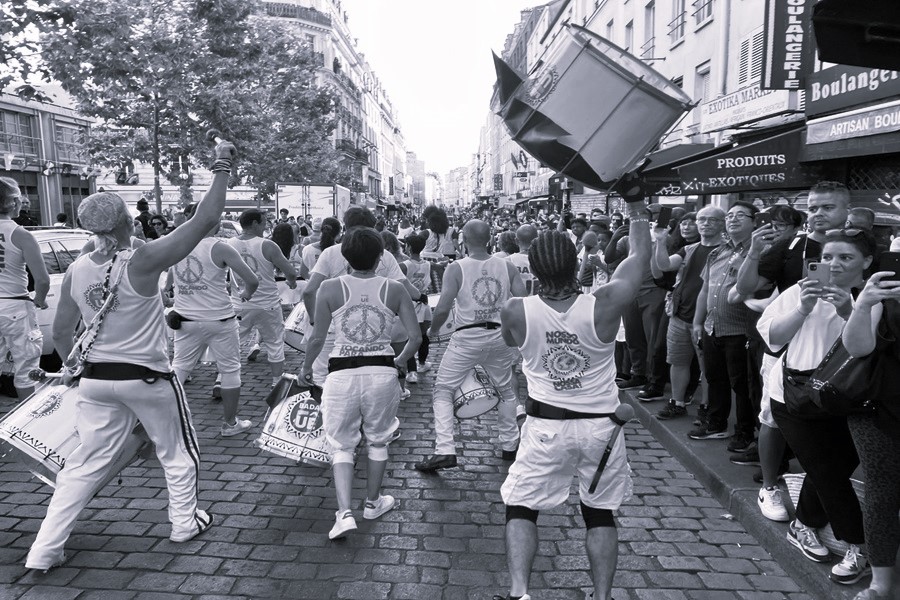This article is part of our Premium Content Stream, a new Property Chronicle initiative to bring you additional high quality analysis of multiple asset classes. It is currently available for all to read but shortly we will be introducing a modest monthly subscription to access this and new articles within the stream.
The Belleville Batucada lights an Olympic Flame
Spring Training complete, my Olympic volunteering experience began on 14 July.
On France’s National Day, after an extensive tour of France, the energy of the Olympic Flame finally touched the lives of hundreds of thousands of Parisians. The torch relay also brought my first Olympic duties.
The rue de Belleville, spanning the 19th and 20th arrondissements in eastern Paris, is unfamiliar territory throughout almost thirty years of working from central Paris and living to the west of the city. Until last week, my superficial knowledge of Belleville consisted of two things; firstly, that in French Monopoly, Belleville is the cheapest property on the board – the equivalent of Old Kent Road – and secondly, that rue de Belleville has recently been voted one of the “coolest streets in the world” by Time Out magazine.
My first Olympic “shift” was but one of about thirty similar events across Paris’ twenty arrondissements. To celebrate the Flame’s arrival at each venue, cultural events included can-can dancing, rollerblading, kite flying and pétanque. My allotted task was effectively to act as “sweeper” to a samba percussion group—by walking immediately behind their parade down the long rue de Belleville.
Up close, the graffiti and noise of the district are certainly not the idyllic tourists’ image of Paris. Starting from the capital’s highest point, the steep and partly cobbled street is lined with multicultural shops, bars and restaurants. Belleville is certainly cosmopolite, a diversity clearly in the organisers’ thinking in selecting Brazilian, Asian and African performers as warm-up acts to the district’s torchbearers.
BADAUÊ, the percussion group I followed, have been regular performers in Paris and their Brazilian “Batucada” is defined as a style of “repetitive, fast-paced percussive samba”. Dance is a key part of a Batucada, and two exotically dressed performers led about twenty drummers who flamboyantly launched their instruments above their heads. The synchronised rhythm of the drums was very fast, very catchy and very loud. Samba certainly moves people; both physically and emotionally.
Along the length of the parade, spectators packed the pavements and swayed and smiled in the warm early evening sunshine. Belleville residents, often five deep in front of bars and cafés, leaned out of their apartment windows and revelled in the moment. It was both joyful and curious to feel the percussive rhythms of Latin America in an unmistakeably Parisian streetscape. Luckily for me, walking just behind the Batucada group proved to be the best seat in the house and it was a treat to be watching the people watching the performers.
After a half hour march to the beat of the drums, the Belleville Batucada finished, and the colourful Asian Lion Dance joined us on Place de la République. Back up the hill, the warm-up acts had been followed by the chosen torchbearers. All dressed in figure-hugging white outfits, these relayeurs were an interesting mix; Aya, a former Olympic lady boxer, Matteo, a Paralympic wheelchair fencer and, less athletically, a local Belleville celebrity, Tharshan Selvarajah, a Sri Lankan boulanger and holder of the prestigious annual award for “best baguette in Paris”.
Financial sector executives took over the Flame and jogged alongside a giant dancing squirrel; the emblem of their Olympic sponsor bank. The bright red float of Coca-Cola, another Olympic “partner”, pumped out music like the caravanes which whip up the Tour de France’s crowds before the bikes fly past. In contrast to the Tour, however, the spectators from Belleville’s torch relay did not need whipping up. After the sounds and sights of Brazil and Asia, the growing crowd on the Place was already rocking.
The official website of the local Mairie described our torch relay event as “taking the public on a voyage” and there was, briefly, a flavour of both Rio and Tokyo, the two previous Olympic host cities. Even within Paris, I have the impression that my Olympic volunteer journey is helping me rediscover the capital. In recent weeks, I have attended events in the northern, southern and eastern extremities of central Paris (in the 18th, 13th and 20th)—all arrondissements well into double figures and somewhat out of my normal comfort zone.
Already, the world’s biggest sports event is broadening horizons. If last week’s torch relay was a lively foretaste of that, then Friday’s Opening Ceremony on the river Seine will be taking the public on a voyage of particularly grand scale.







